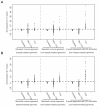Noninvasive prenatal diagnosis of fetal trisomy 18 and trisomy 13 by maternal plasma DNA sequencing
- PMID: 21755002
- PMCID: PMC3130771
- DOI: 10.1371/journal.pone.0021791
Noninvasive prenatal diagnosis of fetal trisomy 18 and trisomy 13 by maternal plasma DNA sequencing
Abstract
Massively parallel sequencing of DNA molecules in the plasma of pregnant women has been shown to allow accurate and noninvasive prenatal detection of fetal trisomy 21. However, whether the sequencing approach is as accurate for the noninvasive prenatal diagnosis of trisomy 13 and 18 is unclear due to the lack of data from a large sample set. We studied 392 pregnancies, among which 25 involved a trisomy 13 fetus and 37 involved a trisomy 18 fetus, by massively parallel sequencing. By using our previously reported standard z-score approach, we demonstrated that this approach could identify 36.0% and 73.0% of trisomy 13 and 18 at specificities of 92.4% and 97.2%, respectively. We aimed to improve the detection of trisomy 13 and 18 by using a non-repeat-masked reference human genome instead of a repeat-masked one to increase the number of aligned sequence reads for each sample. We then applied a bioinformatics approach to correct GC content bias in the sequencing data. With these measures, we detected all (25 out of 25) trisomy 13 fetuses at a specificity of 98.9% (261 out of 264 non-trisomy 13 cases), and 91.9% (34 out of 37) of the trisomy 18 fetuses at 98.0% specificity (247 out of 252 non-trisomy 18 cases). These data indicate that with appropriate bioinformatics analysis, noninvasive prenatal diagnosis of trisomy 13 and trisomy 18 by maternal plasma DNA sequencing is achievable.
Conflict of interest statement
Figures



References
-
- Driscoll DA, Gross S. Clinical practice. Prenatal screening for aneuploidy. N Engl J Med. 2009;360:2556–2562. - PubMed
-
- Tabor A, Philip J, Madsen M, Bang J, Obel EB, et al. Randomised controlled trial of genetic amniocentesis in 4606 low-risk women. Lancet. 1986;1:1287–1293. - PubMed
-
- Malone FD, Canick JA, Ball RH, Nyberg DA, Comstock CH, et al. First-trimester or second-trimester screening, or both, for Down's syndrome. N Engl J Med. 2005;353:2001–2011. - PubMed
-
- Wapner R, Thom E, Simpson JL, Pergament E, Silver R, et al. First-trimester screening for trisomies 21 and 18. N Engl J Med. 2003;349:1405–1413. - PubMed
-
- Lo YMD, Corbetta N, Chamberlain PF, Rai V, Sargent IL, et al. Presence of fetal DNA in maternal plasma and serum. Lancet. 1997;350:485–487. - PubMed
Publication types
MeSH terms
Substances
LinkOut - more resources
Full Text Sources
Other Literature Sources
Medical
Miscellaneous

